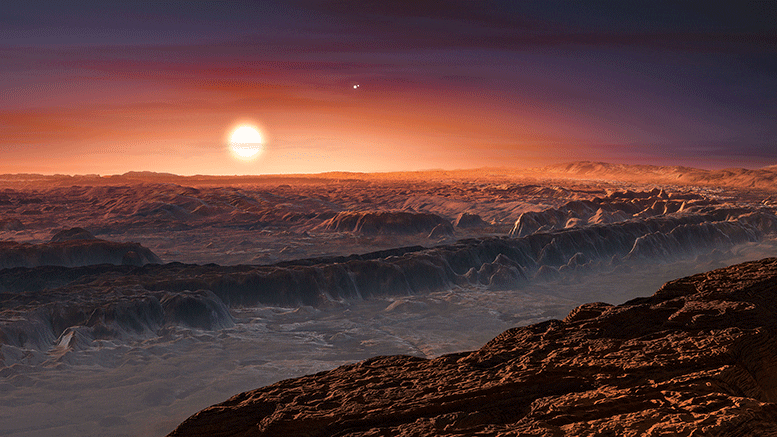
This artist’s impression shows a view of the surface of the planet Proxima b orbiting the red dwarf star Proxima Centauri, the closest star to the Solar System.
The existence of a planet the size of Earth around the closest star in the solar system, Proxima Centauri, has been confirmed by an international team of scientists including researchers from the University of Geneva (UNIGE).
The results, which you can read all about in the journal Astronomy & Astrophysics, reveal that the planet in question, Proxima b, has a mass of 1.17 earth masses and is located in the habitable zone of its star, which it orbits in 11.2 days.
The ESPRESSO spectrograph has performed radial velocity measurements on the star Proxima Centauri, which is only 4.2 light-years from the Sun, with an accuracy of 30 centimeters a second (cm/s) or about three times more precise than that obtained with HARPS, the same type of instrument but from the previous generation.
“We’re really pleased that ESPRESSO can produce even better measurements, and it’s gratifying and just reward for the teamwork lasting nearly 10 years.”.
Alejandro Suarez Mascareño, the article’s main author, adds: “Confirming the existence of Proxima b was an important task, and it’s one of the most interesting planets known in the solar neighborhood.”.
The measurements performed by ESPRESSO have clarified that the minimum mass of Proxima b is 1.17 earth masses (the previous estimate was 1.3) and that it orbits around its star in only 11.2 days.
“ESPRESSO has made it possible to measure the mass of the planet with a precision of over one-tenth of the mass of Earth,” says Michel Mayor, winner of the Nobel Prize for Physics in 2019, honorary professor in the Faculty of Science and the ‘architect’ of all ESPRESSO-type instruments?
Although Proxima b is about 20 times closer to its star than the Earth is to the Sun, it receives comparable energy, so that its surface temperature could mean that water (if there is any) is in liquid form in places and might, therefore, harbor life.
In fact, the Proxima star is an active red dwarf that bombards its planet with X rays, receiving about 400 times more than the Earth.
We’re going to tackle all these questions, especially with the help of future instruments like the RISTRETTO spectrometer, which we’re going to build specially to detect the light emitted by Proxima b, and HIRES, which will be installed on the future ELT 39 m giant telescope that the European Southern Observatory (ESO) is building in Chile.”.
“If the signal was planetary in origin, this potential other planet accompanying Proxima b would have a mass less than one third of the mass of the Earth.
“a planet the size of Earth around the closest star in the solar system, Proxima Centauri”
Did you mean “closest star to our solar system?”
May 27, 2020
